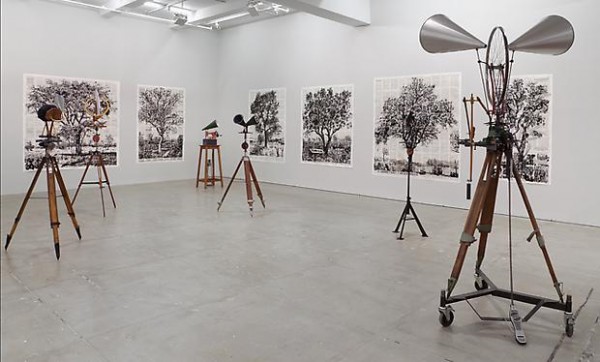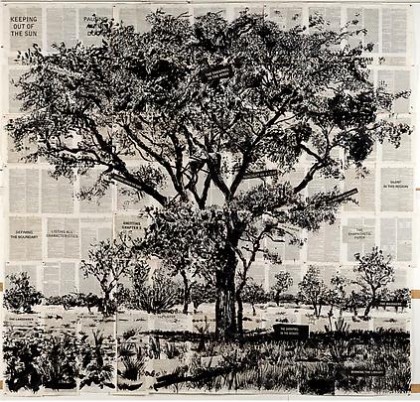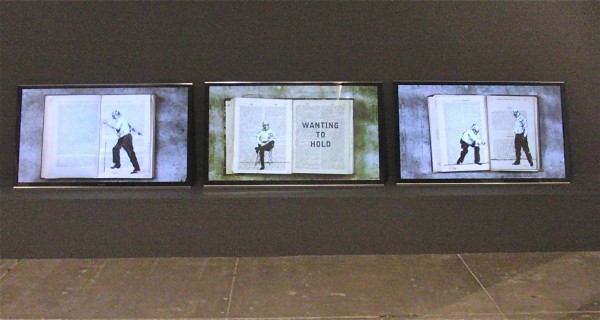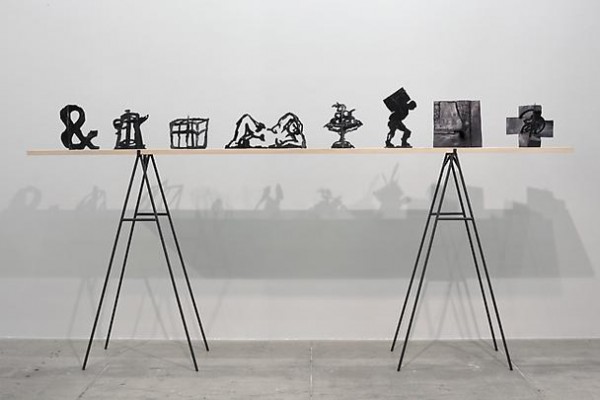
William Kentridge’s latest show at Marian Goodman is another multimedia wonder (photo courtesy Marian Goodman Gallery)
Marian Goodman Gallery
24 West 57th St. between Fifth & Sixth Aves.
Through October 26, free, 10:00 am – 6:00 pm
212-977-7160
www.mariangoodman.com
In his latest exhibit at the Marian Goodman Gallery in Midtown, “Second-hand Reading,” South African multidisciplinary artist William Kentridge examines the concepts of construction, deconstruction, and reconstruction in unique, creative, and, as always, playful ways as they relate to both the artist himself and the viewer. As he noted in “Drawing Lesson One: In Praise of Shadows,” the first of six hour-long Charles Eliot Norton Lectures he gave in the spring of 2012 during his one-year residency at Harvard, we are “made aware of our part in the construction of the image, our part in the construction of the illusion, but most importantly our part in the construction of ourselves. It is in the gap between the object and its representation that this energy emerges, the gap we fill in.” Over the course of the talks, which can be viewed here, Kentridge also discusses mistranslation, practical epistemology, meaning, shadows, words, seeing, the movement between images and ideas, anti-entropy, and life in the studio, where he makes all of his work.

William Kentridge, “The Shrapnel in the Woods,” India ink on CRAGGS UNIVERSAL TECHNOLOGICAL DICTIONARY (1826), 2013 (photo courtesy Marian Goodman Gallery)
As complex as his talks can get, Kentridge also instills his trademark sense of humor and explores his very personal inclusion of the hand — and full body — of the artist, two elements that are central to the new show, which continues through October 26. “Second-hand Reading” is filled with energy, and its myriad rewards are indeed affected by how much constructing visitors do in their mind. The North Gallery is dominated by kinetic machines, including repurposed megaphones, sewing machines, a bicycle wheel, and a drum kit hanging from the ceiling, all of which must be operated by a gallery employee, who will do so for the asking. Surrounding the machines is a series of large-scale India ink drawings on pages from Craggs Universal Technology Dictionary, featuring trees on which Kentridge has added such phrases as “Tear & Repair,” “The Nicely Built City Never Resists Destruction,” and “The Death of Trees.” The trees not only represent life in South Africa but the source of the paper on which they are drawn; in today’s society, of course, less and less writing is being done on paper.
In the North Viewing Room, the triptych flip-book “NO, IT IS” consists of three extremely entertaining continuous and simultaneous flipbook videos (Workshop Receipts, The Anatomy of Melancholy, and Practical Enquiries) of black-and-white images and different-colored geometric shapes on pages from an old technical encyclopedia. As the pages turn, Kentridge walks across them, takes a seat, and dances with a woman; at the beginning and end, Kentridge’s hand can be seen opening and closing the book. The drawings used for the films hang on the walls of the small space.

William Kentridge, “NO, IT IS,” triptych of three flipbook films, HD video, 2012 (photo by twi-ny/mdr)
In the Conference Room, linocuts of trees are printed on sheets taken from the Shorter Oxford English Dictionary and the Encyclopedia Britannica, while silkscreens on pages from the 1746 Septem Linguarum Calepinus, the 1757 AD Pandectas Duobus Tomis Dilftributus, and other books declare in bold red, “A Safe Space for Stupidity,” “The Full Stop Swallows the Sentence,” and “Against Argument (But Not This One),” phrases Kentridge wrote down while preparing the Harvard lectures.

William Kentridge’s “Rebus” sculptures are best experienced from multiple angles (photo courtesy Marian Goodman Gallery)
In the South Gallery in the back, two rows of “Rebus” sculptures consist of black bronze works that are like puzzles, changing when viewed from different angles. A lithograph of nine black-and-white typewriters reminds us of how words were at one time put onto the page. “Let Us Enter the Chapter” and “All the Trees in the Library” comprise small drawings on pages of the Shorter Oxford English Dictionary with such words at the top as “Abuse,” “Advocate,” “Wrath,” “Void,” “Symptom,” “Graveyard,” and “Indecipherable.” The show culminates with the poetic seven-minute flipbook film “Second-hand Reading,” which is composed of the many disparate elements in the South Gallery as a concerned Kentridge makes his way across pages from Cassell’s Cyclopædia of Mechanics on which he has added such phrases as “Whichever page you open, there you are” and a cheerleader with a cross on her outfit waves flags as if sending a message, all set to a beautiful score by Neo Muyanga. The exhibit as a whole places Kentridge’s art very firmly in a different kind of age of mechanical reproduction while laying bare his thought process. He is “taking sense and deconstructing it, taking nonsense and seeing if sense can be constructed from it,” as he recently explained, and asking the viewer to participate in the ultimate creation of meaning. The title of the show itself evokes a multitude of meanings, as “second-hand” could refer to Kentridge’s reuse of found objects, the portrayal of his own actual hand, his breathing life into pages from old texts that people can now read in a new light, and the endless passage of time, which hovers over everything. But even more important, it’s all a helluva lot of fun.
(Kentridge fans can still see his visually stunning production of The Nose at the Metropolitan Opera on October 26 and in theaters October 26 and 30, and the Metropolitan Museum of Art just opened their latest Kentridge acquisition, “The Refusal of Time,” which runs through May 11. To read our 2011 twi-ny talk with Mr. Kentridge, please go here.)